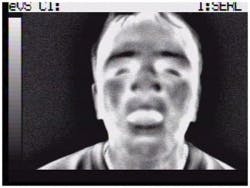While biometric identification methods such as iris mapping and fingerprint analysis rely on cooperation of the participant, face recognition is a more covert means for identifying individuals in a crowd for safety and security applications. Because visible-light face recognition algorithms can be sensitive to variations in illumination conditions, researchers at Concordia University (Montreal, QC, Canada) are pursuing an alternative thermal-IR approach that is invariant to illumination changes.
Appearance-based (global face properties) and feature-based (facial features such as eyes or mouth) algorithms often assume a Gaussian model for extracted IR face features; however, the researchers found that this assumption is not always appropriate and instead took an appearance-based approach using unsupervised Bayesian learning of finite generalized Gaussian-mixture models. This method can be divided into two steps: feature extraction and similarity measurements. Feature extraction takes into consideration shape and texture information by applying edge orientation histograms and calculating a set of features derived from the co-occurrence matrices. For similarity measurements, the Bayesian approach was used to model each class in the training set and to assign each image to the class in which it belongs. This Bayesian approach outperformed six other methods because of its ability to incorporate prior information.
Contact Nizar Bouguila at [email protected].
About the Author

Gail Overton
Senior Editor (2004-2020)
Gail has more than 30 years of engineering, marketing, product management, and editorial experience in the photonics and optical communications industry. Before joining the staff at Laser Focus World in 2004, she held many product management and product marketing roles in the fiber-optics industry, most notably at Hughes (El Segundo, CA), GTE Labs (Waltham, MA), Corning (Corning, NY), Photon Kinetics (Beaverton, OR), and Newport Corporation (Irvine, CA). During her marketing career, Gail published articles in WDM Solutions and Sensors magazine and traveled internationally to conduct product and sales training. Gail received her BS degree in physics, with an emphasis in optics, from San Diego State University in San Diego, CA in May 1986.
